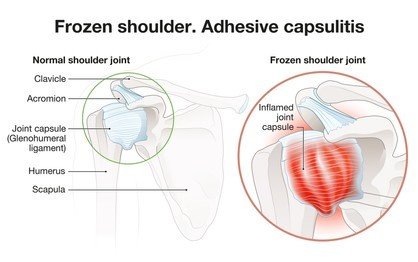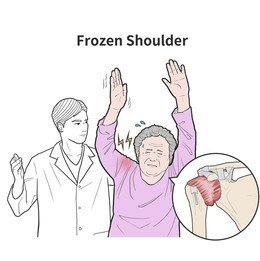Adhesive capsulitis, another name for frozen shoulder, is a disorder marked by stiffness and restricted range of motion in the shoulder joint. Three stages are usually experienced: freezing, frozen, and thawing. While it can resolve on its own over time, the condition can cause significant discomfort and impairment in daily activities. Fortunately, recent advances in frozen shoulder treatment have provided new non-surgical options for managing the condition and accelerating recovery. This article explores the latest research and approaches in frozen shoulder treatment that focus on non-invasive and conservative methods.

Improved Understanding of Pathophysiology:
Recent research has shed light on the underlying mechanisms of a frozen shoulder, including inflammation, fibrosis, and synovial tissue changes within the shoulder joint. This enhanced understanding has informed the development of more targeted treatment approaches that address the root cause of the condition, rather than just managing symptoms.
Tailored Physical Therapy Programs:
Physical therapy remains a cornerstone of frozen shoulder treatment, but advances in this field have led to more tailored programs. These programs incorporate individualized exercises and stretches based on the patient’s stage of frozen shoulder and specific needs. Emphasis is placed on gradually increasing the range of motion and strength while avoiding excessive pain or discomfort.
Manual Therapy Techniques:
In addition to exercises, manual therapy techniques such as joint mobilization and soft tissue massage have shown promise in relieving symptoms and improving shoulder mobility. Skilled physical therapists use these hands-on approaches to manipulate the shoulder joint and surrounding tissues, promoting flexibility and reducing stiffness.
Steroid Injections and Anti-Inflammatory Medications:
While steroid injections have been a standard treatment for frozen shoulder, recent research has focused on optimizing the timing and dosage to maximize benefits while minimizing potential side effects. Additionally, non-steroidal anti-inflammatory drugs (NSAIDs) can help manage pain and inflammation, allowing patients to engage more effectively in physical therapy.
Platelet-Rich Plasma (PRP) Therapy:
Platelet-rich plasma (PRP) therapy is an emerging approach in the treatment of frozen shoulder. PRP is derived from the patient’s own blood and contains growth factors that promote healing and tissue regeneration. Research suggests that PRP injections may help reduce pain and improve range of motion in patients with frozen shoulder.
Shockwave Therapy:
Shockwave therapy, also known as extracorporeal shockwave therapy (ESWT), is a non-invasive treatment that uses acoustic waves to stimulate healing in the shoulder joint. This approach has shown promise in reducing pain and improving function in patients with frozen shoulders by promoting blood flow and tissue repair.
Acupuncture and Traditional Chinese Medicine:
Acupuncture and traditional Chinese medicine (TCM) have gained popularity as complementary treatments for frozen shoulder. Thin needles are inserted into certain body locations during acupuncture treatments in order to promote energy flow and reduce pain. While more research is needed, some studies suggest that acupuncture and TCM may be beneficial in managing symptoms and improving mobility.
Ultrasound-Guided Interventions:
Ultrasound-guided injections allow healthcare providers to deliver medications directly to the affected area with precision. This approach can improve the effectiveness of treatments such as corticosteroid injections and PRP therapy, potentially leading to better outcomes for patients.
Novel Therapeutic Agents:
Researchers are exploring new therapeutic agents, such as hyaluronic acid injections and other anti-inflammatory compounds, for the treatment of frozen shoulder. These agents may offer additional options for pain relief and improved mobility without the risks associated with steroid use.
Education and Self-Management Strategies:
Empowering patients with knowledge about frozen shoulder and teaching self-management strategies is an essential part of treatment. Patients can benefit from learning how to modify activities to avoid aggravating the shoulder and how to perform exercises safely at home to maintain progress made in physical therapy.

Conclusion
Advances in frozen shoulder treatment have expanded the range of non-surgical options available to patients, providing more effective ways to manage symptoms and accelerate recovery. From tailored physical therapy programs and manual therapy techniques to emerging approaches such as PRP therapy and shockwave therapy, there are numerous ways to address the condition without resorting to surgery. As research continues to explore novel therapeutic agents and complementary treatments, patients with frozen shoulders can look forward to more innovative and personalized care options. By staying informed about the latest advances and working closely with healthcare providers, individuals with frozen shoulders can achieve better outcomes and regain their quality of life.
For any further queries, Plz visit drsmitagulatipainrelief.com



